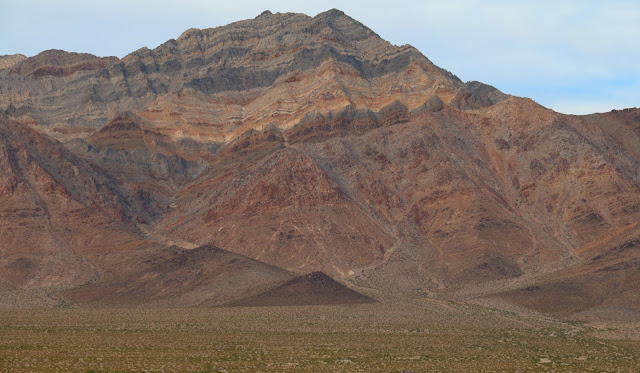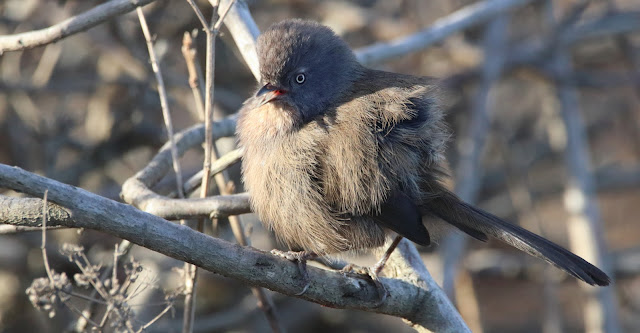Snow
Geese overhead
1-18 November 2018 -- WEST COAST TOUR
Las Vegas – Lone Pine – Lee Vining – Sausalito – Arcata – Orick
– Portland –
Seattle – Lopez Island – Skagit Flats – Leavenworth –
Wenatchee – Spokane
Anna’s
Hummingbird male
I arrived in Las Vegas in the early afternoon, noting the lines
of slot machines bracketing the halls of the airport arrival lounge. I drove my
rental car north up highway 95, passing the Snow Mountain Indian Reservation,
the Tule Springs Fossil Beds, Creech Air Force Base, as well as a number of unmarked
desert installations that appeared to be underground missile launch facilities.
I stopped to photograph a beautiful stratified mountain in the Armargosa Desert
east of Beatty and later learned this was the western verge of Yucca Mountain,
which has been slated to be the permanent underground repository for the US’s
vast store of nuclear waste.
Yucca
Mountain
On this drive north from Vegas, not a tree was to be seen in
this desert landscape. At Beatty, I stopped for water, because I would next be
crossing Death Valley. The convenience store featured all sorts of illustrations
of extra-terrestrials, because the infamous Area
51 is just a few miles to the east on the other side of Yucca Mountain. I
turned southwestward to cross Daylight Pass of the Armargosa Range, which
brought me into Death Valley National Park. The sun began to set behind the
mountains as I descended through the barren but scenic landscape toward
Stovepipe Wells. I then ascended another desert range to cross into the valley
of Panamint Springs. The sky darkened in this stark landscape. I passed over a
third range and wound down into the Owens Valley of California, stopping for
the night at Lone Pine, California.
Golden
Eagle
I arrived in Lone Pine well after dark. The next morning I
was out early in the chill for a look at Owens Lake—the body of water drained
by the Los Angeles aqueduct (recall the movie Chinatown). There are now attempts
to restore the lake, in part for the migratory waterfowl but also to reduce the
toxic alkaline dust that blows in the dry winds, choking the Lone Pine environs
at times. I birded the lake but this was clearly off-season—there were small
numbers of ducks, peeps, and Eared Grebes but not much else.
Whitney Range vista
From Lone Pine, I drive up to Whitney Portal at 8,350 feet
elevation—the gateway to hikers wishing to climb the highest peak in the Lower
48. The vistas of the Whitney Range were stunning in the morning sunlight. Here
the temperature was below freezing and the deep rocky ravine was darkened by
Douglas Fir with 6-foot-diameter trunks. Here I found Steller’s Jays roaming
the parking lot, looking for hand-outs from the hikers who were preparing to
climb the big mountain.
Steller’s
Jay
Driving north from Lone Pine, I had a nice Mexican lunch in
Bishop and then in the early afternoon I arrived in Lee Vining, the small town
overlooking Mono Lake. I spent the afternoon south of Mono Lake in a large
stand of Jeffrey Pines, searching for birds and for the large and sturdy cones
of this pine—some reaching 9 inches. This is the most handsome of the world’s
pine cones. I collected several to share with friends. The open stand of the pines
was populated by small squeaking flocks of Pygmy Nuthatches.
Pygmy
Nuthatch
Over the next day-and-a-half I birded the Mono Lake
environs. The lake was pretty quiet at this time, with grebes and a few ducks.
Better to be here in early June, when the breeders are here. Land birds were
more abundant. I found Bushtits in the shrubbery of the small state park on the
northwest quadrant of the lake. Birding in November is generally quiet, with
many of the summer species already gone...
Bushtit
On the 3rd of November, after breakfast at Nicely’s
Restaurant in downtown Lee Vining, I headed up the Tioga Road, crossing the
Sierras through Yosemite National Park. This is a road of stupendous rocky vistas
throughout and beautiful conifer forests. I stopped up in the pass (elevation
9,943 ft) in the cold morning light, searching for birds in the small parkland
pines. Here I found Mountain Chickadee and Red-breasted Nuthatch.
Mountain
Chickadee
Red-breasted
Nuthatch
Near the bottom of the road on the western side of the
Sierras, I stopped at the Tuolumne Grove to admire the huge Sugar Pines (the
largest pine on Earth), White Fir, and Giant Sequoias (the largest of all trees
by mass). One is never prepared for the grandeur of these titanic and ancient
living remnants of another age. The Sugar Pines carry giant cones that can
reach 18 inches in length. Sadly, here I saw numbers of dead pines, apparently
victims of the white pine blister rust. The sequoias, unaffected by the rust,
are so massive that it is impossible to properly describe them, except to say
some of these giants are more than 20 feet in diameter and more than 3,000
years old. They are difficult to photograph.
Giant
Sequoia
Interior Live
Oak
From the big trees I headed west across the foothills on a seriously
winding road (highway 120) and then down across the Sacramento Valley to the
Richmond Bridge, that took me to Marin County, my next stop being Sausalito to
visit with birding pen-pal Amy Tan and Lou DeMattei and to give a book talk at
the Book Passage By-the-Bay store. Highlight of my stay with Amy and Lou was
our birding adventure across Marin County.
Wrentit
We were guided by Mike Parr, President of the American Bird
Conservancy, and Marin County expert naturalist David Wimpfheimer (and his wife
Patty). Our little birding party was joined by Beth, Shawn, and Fiona Gillogly,
and veterinarian and wild felid expert Kathy Gervais.
Fiona
and Amy on Drake's Beach
Hutton’s
Vireo
We birded the verges of Muir Woods, Stinson Beach,
Bolinas, Inverness, and Drake’s Beach
and the Chimney Rock environs out near Point Reyes point.
birders backlit on Pt. Reyes
Western
Grebes
Highlights included Elephant Seals, Elk, many loons and
grebes, Wrentit, Long-billed Curlew, a big flock of Band-tailed Pigeons, Great
Horned Owl, Barn Owl, Hutton’s Vireo, Townsend’s Warbler, and Tricolored
Blackbird. Also we had a fun visit to Keith Hansen’s Gallery in Bolinas where
we chatted with the bird artist and watched hummingbirds at his feeders.
Great
Horned Owl
Elephant
Seals fighting
The weather cooperated and so did the wildlife. We were
lucky to have little wind—the enemy of birding.
Elk
Group
Picture
From
beautiful Sausalito I drove north through hills and valleys of wine grapes on
my way deep into Redwoods country, ending in tiny Arcata, California, at dark. I
had a fun lunch at the rustic Avenue Cafe in Miranda, just south of the main
Redwoods groves... This day featured great stands of Coast Redwoods, the
tallest trees of Earth.
A
stand of Coast Redwoods
Founders
Tree
After lunch I
drove the Avenue of the Giants (no other country road like it) and wandered
through the Founders Grove, in Humboldt Redwoods State Park. The gloom of the understory,
the silence, the soaring trunks, the towering canopy...
Mule
Deer
At the end of
the day I visited the famous Arcata Marsh, but things were pretty quiet there
other than a few ducks...
Bufflehead drake in display
On 8 November I drove up the coast to Crescent City,
California, stopping to admire the amazing vistas out over the ocean. I visited
Redwoods National Park, walking the winding trail through Ladybird Johnson
Grove.
wave
crests off Orick, California
Then I detoured to the Klamath River overlook, parked on a
bluff high above the surf. From there I could hear the sounds of Elephant Seals
down at the river’s mouth.
Klamath
mouth vista
I spent the night with Todd Stevenson in Portland, Oregon.
Todd and I had worked together at Conservation International. Todd showed me
the sights of downtown Portland. The next morning we walked a nearby city park
and had a close encounter with a Pacific Wren. This delighted Todd’s daughter, named
Wrenn! It rained lightly as I drove into Washington state toward Seattle.
Pacific
Wren in song
I met up with Lisa Dabek in Seattle on the afternoon of the
9th, and we drove up to stay with Lisa’s partner Bruce Ellestad at
his cliff-side home on picturesque Lopez Island, in the San Juans.
Black
Oystercatchers
The three of us spent the long Veteran’s Day weekend on
Lopez, which is beautiful, rural, and birder-friendly. We visited the various
coastal hotspots such as Shark Reef, Agate Beach, Point Colville, and Iceberg
Point. Highlights included Black Oystercatcher, Black Turnstone, and Harlequin
Duck.
Lisa D. and Bruce E. birding Iceberg Point, Lopez Island
On our way back to Seattle, Lisa and I birded the Skagit
flats, encountering a huge flock of Snow Geese. The views from the Skagit that
day were mind-blowing—the snowy peaks in the distance both east and west...
Blue
Goose among a Snow Geese flock on the Skagit flats
Snow Geese Aloft
Snows of Mt
Baker to the west
After a couple of days in Seattle, where I gave two book
talks at Woodland Park Zoo, I drove Route 2 east across Stevens Pass in the
first serious rain of my trip. It was 46oF atop Stevens Pass and
several miles down the eastern slope it was 33oF and ice covered the
road and glazed the conifers. After a quick lunch at the 59er Cafe (newly
restored after a fire), I drove into the faux-Bavarian town of Leavenworth in
the beautiful foothills of the eastern Cascades.
59er
Diner, 15 min. west of Leavenworth, WA
Here the Wenatchee River tumbles down out of the mountains. This
time of year it makes a colorful scene.
Wenatchee
River and autumn colors
Dipper
Leavenworth is gorgeously situated with vistas of mountains
in nearly every direction—the eastern Cascades’ answer to Telluride.
Leavenworth
vista
I gave a Red Barn lecture at the Wenatchee River Institute
in Leavenworth and stayed on the Institute campus. The next morning after the
fabulous hot breakfast at O’Grady’s at the Sleeping Lady resort, I hunted for
White-headed Woodpeckers in the Ponderosa Pine flats of Icicle Creek—one of the
best birding locations in these parts.
White-headed
Woodpecker female
Douglas’s
Squirrel
From there I visited Suzanne Tomassi and Mike Kaputa at
their home in Wenatchee, about 40 minutes drive down hill from Leavenworth. I
had departed Bavaria and entered the Apple Capital! The dry foothills were
cloaked in orchards. Here I gave a book talk that Suzanne organized for me at
the historical Wenatchee Museum and Cultural Center.
Barn
and horses in Palisades valley
Columnar basalt cliffs of Palisades Valley
On the 16th
I toured stunning Palisades Valley, about a half hour drive southeast of
Wenatchee. This grand but rural and dry valley is enclosed by two parallel
walls of imposing dark cliffs of basalt more than a thousand feet high. Here I
was in a world apart, where ravens and raptors soar along the high cliff edges.
The head of the valley has the look of a Lost World. The 15-million-year-old flood
basalt volcanic flows that produced these thick beds must have been fantastic
and infernal at the time of their deposition.
Northern
Harrier female
On the 18th
I rose early and drove across Washington state to Spokane, stopping at Ephrata
for breakfast, passing through the channeled scablands, and visiting Turnbull
National Wildlife Sanctuary south of Cheney for some last birding before
catching my flight home. Rough-legged Hawks were the feature bird of the day,
hovering over the highway in the bright sunny morning. A nice bird to send me
on my way back to the East Coast.
Barn
in plains of central Washington
Rough-leg
hovering











































